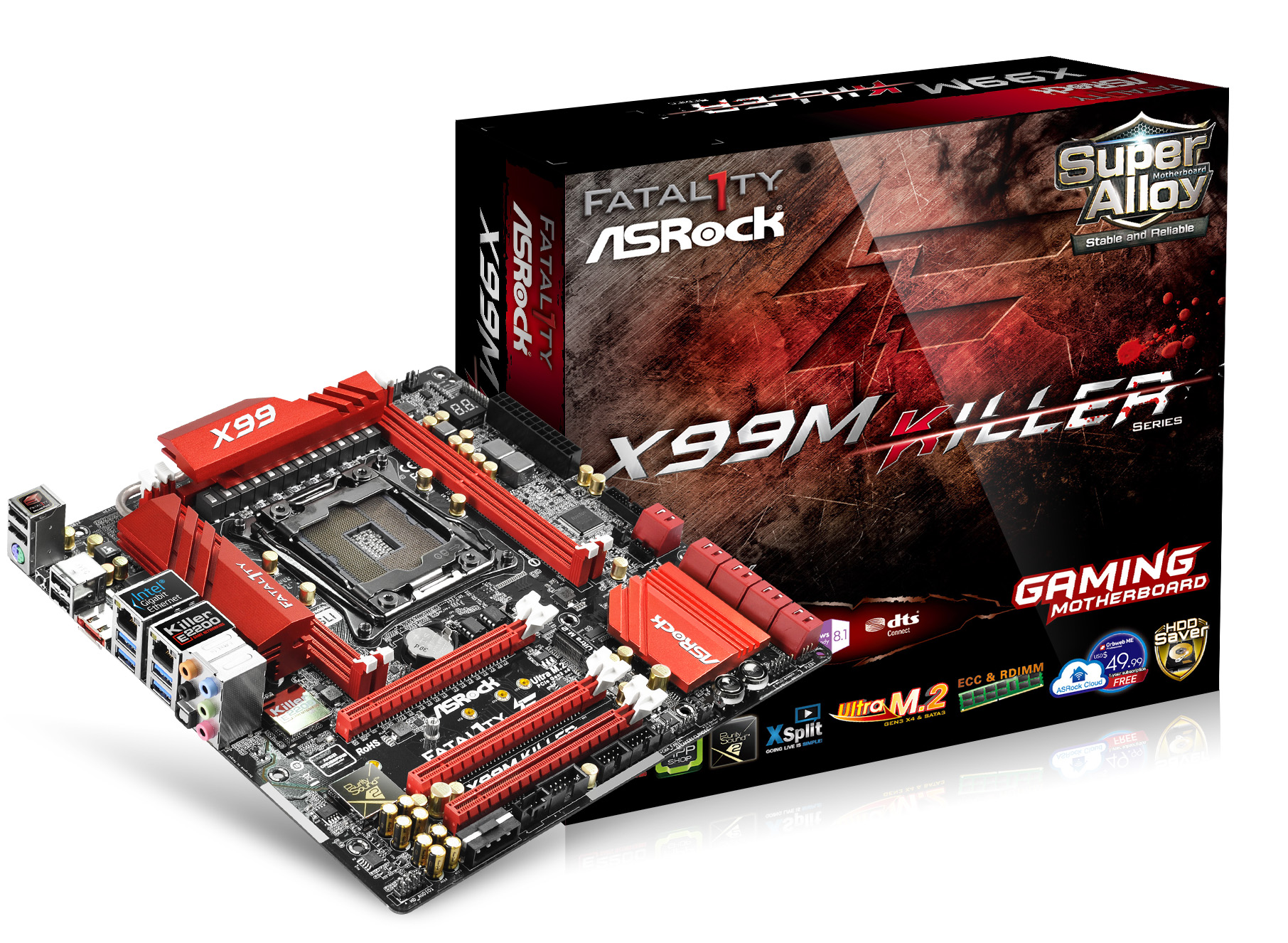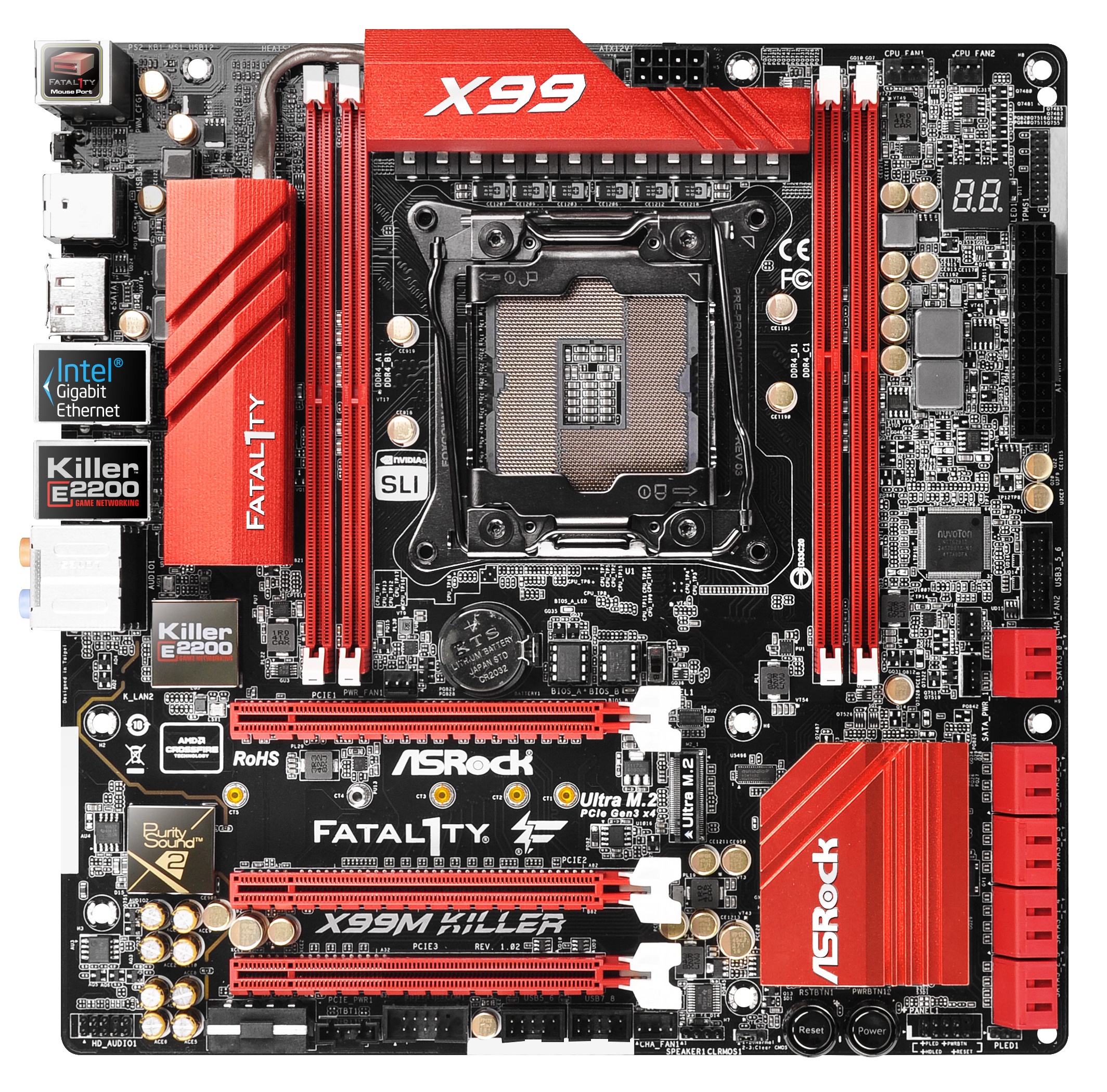ASRock Takes the Throne for World's First Micro-ATX X99 Motherboard
ASRock has built the world's first Micro-ATX X99 motherboard.
ASRock has shared some pictures of the X99M Killer, the "world's first" Micro-ATX motherboard featuring the LGA2011-3 socket and X99 Express chipset, and it looks like a well-balanced board.
The X99M Killer comes with four DDR4 memory slots, which is four less than the full-size X99 ATX boards we've been seeing. Given the form factor, this isn’t surprising, and for most folks it's probably an acceptable compromise. For expansion, the motherboard has three PCI-Express 3.0 x16 slots with support for SLI or CrossFire graphics card configurations. Storage connectivity is covered by ten SATA3 (6 GB/s) ports along with a single Ultra M.2 slot. The Ultra M.2 slot is driven by four PCI-Express 3.0 lanes, which is more than the two PCI-Express 2.0 lanes we find on most boards. Towards the center of the motherboard we can also see two removable chips next to a switch; we suspect that this is a dual-BIOS feature.
When we asked why ASRock was leaving out SATA-Express on its X99 boards, the answer we got was that there doesn’t appear to be enough SATA-Express devices out on the market. We can’t really fault ASRock for making this design choice, as we imagine that few people will miss the SATA-Express connectivity. We’re much happier to see the Ultra-M.2 slots on all its boards.
Rear I/O consists of two Fatality USB 2.0 peripheral ports, a single PS/2 port, two standard USB 2.0 ports, an eSATA port, four USB 3.0 ports, dual gigabit Ethernet ports (one from Intel and the other a Killer E2200), and analog HD audio, which is driven by the Purity Sound 2 hardware. Also present is an optical TOSLINK output.
The X99M Killer has all the storage connectivity, dedicated audio, and networking features of a full-size ATX board. The only real sacrifices that it makes are in memory, which won’t bother most folks, and expansion, although you can still run dual-GPU setups without any trouble. For most folks interested in the X99 platform, this board is a perfect combination of size and capabilities.
No word on pricing yet, though we expect the board to become available around the same time as the Haswell-E CPUs are to debut, which is rumored to be August 29.
Follow Niels Broekhuijsen @NBroekhuijsen. Follow us @tomshardware, on Facebook and on Google+.
Get Tom's Hardware's best news and in-depth reviews, straight to your inbox.
Niels Broekhuijsen is a Contributing Writer for Tom's Hardware US. He reviews cases, water cooling and pc builds.
-
fonzy I was going to ask if anyone will be coming out with a MATX board for X99, glad to see at least one company is.Reply
My next PC will be small form factor. -
Steveymoo At least the board still supports quad channel DDR4. Many people think you're not going to see any difference in performance, but this should improve micro stutter in games, and iGPU performance. I remember a long time ago, playing a game called Anarchy Online, testing the difference between single and dual channel memory in a crowded player area. The difference in framerate was immense.Reply -
ingtar33 well.. we should see some small form-factor boards for x99... mostly due to the fact they moved the vrms onto the cpu for haswell which should free up a bit of motherboard space for smaller form factors.Reply -
ko888 Reply13963828 said:well.. we should see some small form-factor boards for x99... mostly due to the fact they moved the vrms onto the cpu for haswell which should free up a bit of motherboard space for smaller form factors.
If the VRMs were really moved onto the CPU die, for Haswell processors, then there would be no need for that heat-pipe VRM cooler that they are using around the CPU socket. -
TechyInAZ Micro ATX is my favorite form factor! Nice seeing X99 in this form factor. However I'd probably still go with Asus' Rampage Gene.Reply -
ingtar33 Reply13964162 said:13963828 said:well.. we should see some small form-factor boards for x99... mostly due to the fact they moved the vrms onto the cpu for haswell which should free up a bit of motherboard space for smaller form factors.
If the VRMs were really moved onto the CPU die, for Haswell processors, then there would be no need for that heat-pipe VRM cooler that they are using around the CPU socket.
the voltage regulation modules were moved off the motherboard for haswell, and onto the cpu. this is a well known thing. however i suspect there is still some need for some type of VRMs on haswell motherboards, most of them at 3+1 setups... not sure how it works... but it certainly relieves a lot of stress off the motherboard. I suspect the giant heatpipe sinks are mostly for show.



